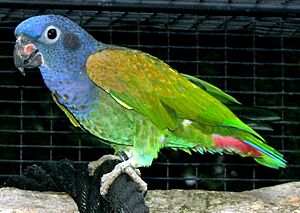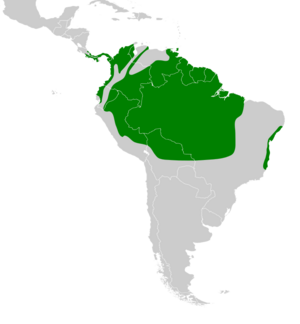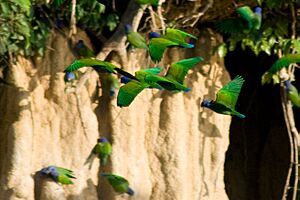Blue-headed parrot facts for kids
Quick facts for kids Blue-headed parrot |
|
|---|---|
 |
|
| Conservation status | |
| Scientific classification | |
| Genus: |
Pionus
|
| Species: |
menstruus
|
 |
|
| Synonyms | |
|
Psittacus menstruus Linnaeus, 1766 |
|
The blue-headed parrot, also known as the blue-headed pionus (Pionus menstruus), is a medium-sized parrot. It is about 27 centimeters (11 inches) long. This bird is mostly green, but it has a bright blue head and neck. It also has cool red feathers under its tail.
You can find these parrots living in warm, tropical places. They live in South America and southern Central America. Their home stretches from Costa Rica and Venezuela all the way down to Bolivia and Brazil. You can even find them on the Caribbean island of Trinidad.
Blue-headed parrots like to live in forests and open areas. This includes places where people grow crops. They prefer humid or wet regions. However, you might see them in drier spots too, especially near rivers. These parrots lay three to five white eggs. They usually lay them inside a hollow tree.
These birds are quite noisy! They make light, high-pitched squeaking sounds. They love to eat fruit and seeds. Sometimes, they even eat grain. At dawn and dusk, many of them gather together. They roost (sleep) in palm trees and other trees. You can see large groups at these roosting spots.
Blue-headed parrots are also popular as pets. They are much quieter than some other parrots, like Amazon parrots. They can be very friendly and affectionate. However, they are not known for being great talkers.
Contents
About the Blue-headed Parrot
The blue-headed parrot is about 28 centimeters (11 inches) long. It weighs around 245 grams (8.6 ounces). Its body is mostly green. Its head, neck, and upper chest are blue. It has red feathers under its tail. Some of its wing feathers are yellowish. The top part of its beak is black with reddish spots. It also has dark patches near its ears.
There are a few different types, or subspecies, of the blue-headed parrot. The ones from southern Central America have lighter feathers. They often have a pinkish patch on their throat. Another type from eastern Brazil has a paler beak. Most of its underside is blue.
Male and female blue-headed parrots look very similar. Young birds have less blue on their heads. They also have red or pinkish feathers around their nostrils. They get their full adult colors when they are about 8 months old. But it can take up to two years for their blue "hood" to fully appear.
Where They Live
The blue-headed parrot mainly lives in the Amazon Basin in South America. This includes areas near the Araguaia River and Tocantins River in the east. There is also a separate group living along Brazil's Atlantic coast. This coastal area stretches for about 1500 kilometers (930 miles).
In northwest South America, their range continues into Central America. You can find them in Panama and Costa Rica. They tend to avoid the high Andes mountains. There are also smaller groups in central Venezuela and northern Colombia. Another group lives along the Pacific coast, from southern Ecuador north to the Caribbean Sea areas of northwestern Colombia and western Venezuela.
What They Eat and How They Breed
Food and Feeding Habits
Blue-headed parrots enjoy a varied diet. They eat different kinds of fruit, flowers, and seeds. Sometimes, they also eat grain.
Breeding and Nests
Blue-headed parrots build their nests inside hollow parts of trees. The female parrot lays white eggs. A typical clutch has three to five eggs. The female sits on the eggs for about 26 days. The baby chicks stay in the nest for about 70 days after they hatch.

Gallery







